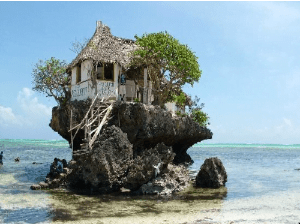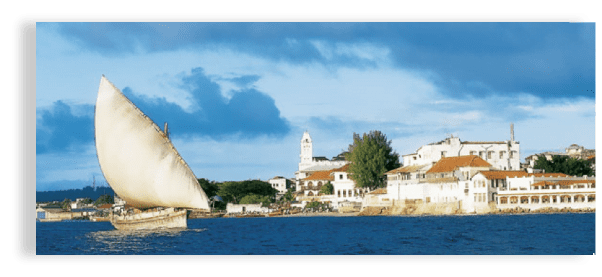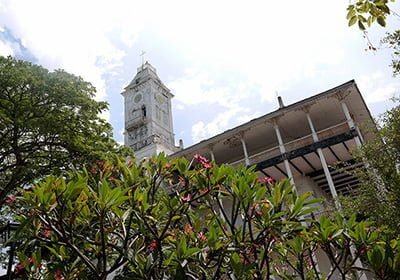Zanzibar
At the heart of this island is the old Stone Town, with its labyrinthine alleyways and architecture. Within easy reach of here is a fine collection of powdery white beaches fringed by coconut palms and sun-baked villages and lapped by the turquoise sea.
Whether you’re arriving for the first time or the fiftieth, Zanzibar never seems to lose its touch of the exotic. After two wind-buffeted and salt-sprayed hours on the ferry (or 20 smooth minutes in a plane), the waters calm and turn turquoise as Stone Town’s skyline slides into view.
The spires of St Joseph’s Cathedral, Forodhani Gardens, the Old Fort, a jumble of rooftops and then the harbor itself – an earthy, timeless mix of grime, touts, dockyard workers and ships. And then, after negotiating passport controls and taxis, you’re there, walking through cobbled alleyways, past women clad in bui-bui, small shops smelling of spices, children playing ball, elderly men dressed in kanzu and kofia playing bao and chatting. Mainland life seems far away as island rhythms take over and (once again) you’re hooked!



Stone Town
It may not have a particularly romantic name, but Stone Town is the old city and cultural heart of Zanzibar, little changed in the last 200 years. It is a place of winding alleys, bustling bazaars, mosques and grand Arab houses whose original owners vied with each other over the extravagance of their dwellings. This one-upmanship is particularly reflected in the brass-studded, carved, wooden doors – there are more than 500 different examples of this handiwork. You can spend many idle hours and days just wandering through the fascinating labyrinth of narrow streets and alleyways.
Stone Town was recently and deservedly declared a World Heritage Site by UNESCO.
 Most of the houses that can be seen today were built in the 19th century when Zanzibar was one of the most important trading centers in the Indian Ocean region. The Coraline rock of Zanzibar was a good building material, but it is also easily eroded.
Most of the houses that can be seen today were built in the 19th century when Zanzibar was one of the most important trading centers in the Indian Ocean region. The Coraline rock of Zanzibar was a good building material, but it is also easily eroded.
This is evident by the large number of houses that are in a bad state of repair. Several buildings have already been renovated and the Stone Town Conservation Authority has been established to co-ordinate the restoration of the town to its original magnificence. Pictured opposite is a ‘before and after’ look at the restoration work done on the Old Dispensary. As a result of sensible policy, nearly all of the major hotels built in Stone Town are housed in renovated buildings.
The Old Dispensary
(now known as the Stone Town Cultural Centre) is a grand four story building with a set of decorative balconies. It served as a dispensary during colonial times but fell into disrepair in the 1970’s and 1980’s. It is one of the Stone Town buildings that has been successfully restored, in this case with funding from the Aga Khan Trust for Culture. It can be found on Zanzibar’s seafront on Mizingani road.
The market
is a great place to visit even if you don’t want to buy anything. It is a vibrant place where everything under the sun is bought and sold. People bring their produce here from all over the island, and other people come to buy things they can’t get in their own villages. Of special interest is the huge selection of brightly coloured khangas (worn by the local women) and the auctions that are held regularly.
Livingstone’s House
was built around 1860 for Sultan Majid, and was used by many of the missionaries and explorers as a starting point. Most notably, Dr David Livingstone lived here before commencing his last journey to the mainland interior.
The Peace Memorial Museum
is an interesting look at Zanzibar’s history. It has sections on archaeology, early trade, slavery, palaces, mosques, sultans, explorers (includes Dr Livingstone’s medical chest), missionaries, colonial administrators, traditional crafts and household items, stamps, coins, fishing, and clove cultivation.
The Palace Museum
is a large white building with castellated battlements, and was built in the late 1890’s for members of the Sultan’s family. Originally called the Sultan’s Palace, in 1911 it became the official residence of the Sultan of Zanzibar, but following the revolution in 1964, it was renamed the Peoples’ Palace. In 1994, the palace was turned into a museum dedicated to the history of Zanzibar’s Sultans which necessitated a third change of name to the Palace Museum. For the first time, visitors can see much of the Sultans’ furniture and other possessions that survived the revolution.
 The House of Wonders
The House of Wonders
is a very large square-shaped building, with several stories, surrounded by tiers of pillars and balconies, and topped by a large clock tower. It was built in 1883 as a ceremonial palace for Sultan Barghash and was the first in Zanzibar to have electric light and an electric lift. Not surprisingly, when it was built, the local people called it Beit el Ajaib, meaning the House of Wonders. Today, it is still one of the largest buildings in Zanzibar, and there are plans to open it as the National Museum.
The Arab Fort
is situated next to the House of Wonders and was built between 1698 and 1701 by the Busaidi group of Omani Arabs. It is a large building with high, dark brown walls. topped by castellated battlements. The fort is open to visitors and now contains various shops and an open air theatre.



